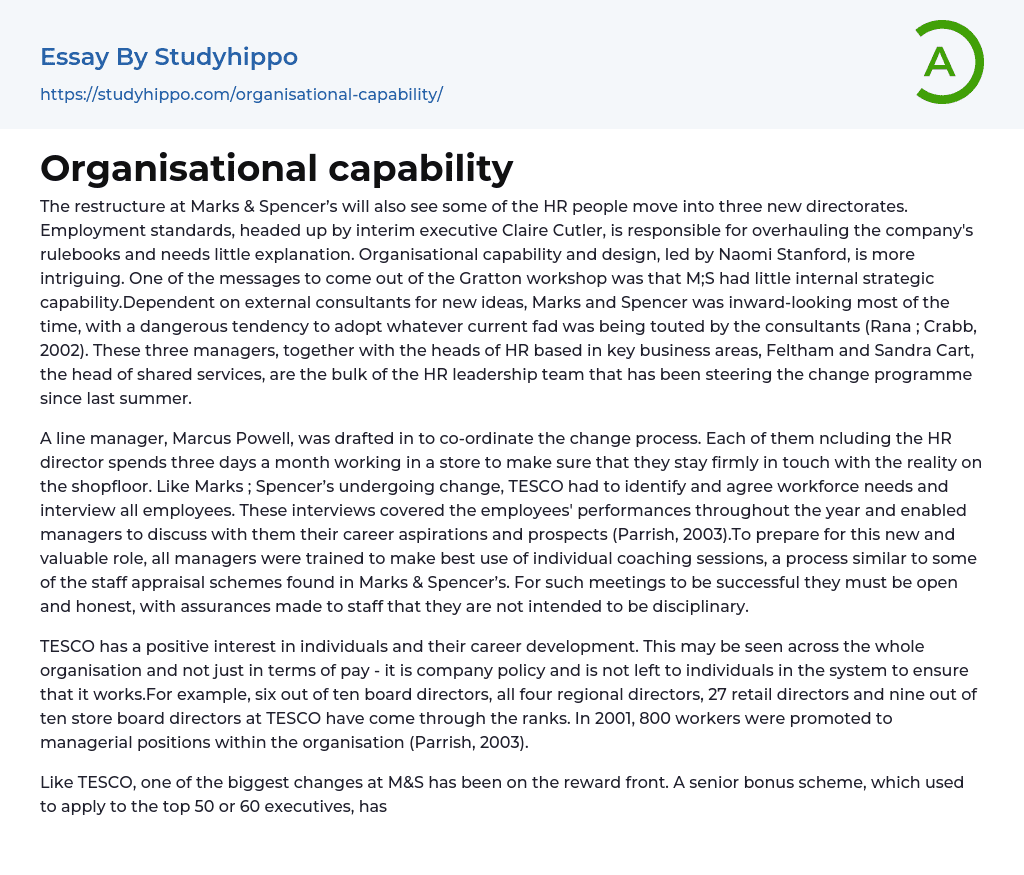The restructuring of Marks & Spencer’s involves some HR personnel transitioning to three new directorates. One of these directorates is Employment Standards, which is being led by interim executive Claire Cutler and is responsible for revamping the company's rules and regulations. The second new directorate is Organisational Capability and Design, headed by Naomi Stanford. During the Gratton workshop, it became apparent that M;S lacked strategic capacity internally and often relied on external consultants for ideas. They were also prone to adopting new trends pushed by these consultants. These three managers, along with HR heads Feltham and Sandra Cart from key business areas and Head of Shared Services, comprise the majority of the HR leadership team responsible for directing the change programme since summer last year.
As part of the change process, Marcus Powell, a line manager, was br
...ought in to coordinate. In an effort to stay connected with the reality on the shopfloor, each month, all managers, including the HR director, spend three days working within the store. TESCO also had to undergo a similar change process as Marks & Spencer's and this included identifying workforce needs and conducting employee interviews. These interviews focused on employee performance throughout the year and allowed for managers to discuss employees' career aspirations. To prepare for these coaching sessions, all managers received training similar to the staff appraisal schemes used within Marks & Spencer's. In order for these meetings to be effective, they had to be open and honest with no disciplinary intentions towards staff.
TESCO has a company policy of valuing individuals and promoting their career development, which is evident throughout the organization and not just reflected in pay. This
commitment is not left to individual employees to enforce. For instance, a significant number of TESCO's board directors, regional directors, retail directors, and store board directors have progressed through the company's ranks. In 2001 alone, TESCO promoted 800 workers to managerial positions within the organization (Parrish, 2003).
Similarly to TESCO, M&S has implemented significant changes in their reward system. Formerly applying only to the top 50 or 60 executives, their senior bonus scheme now encompasses about 1,000 managers (Rana & Crabb, 2002) and is based on profit. Additionally, sales-related bonuses are available to staff four times a year. This has greatly increased performance, as local managers now have greater autonomy when determining bonus allocation.
According to Rana and Crabb (2002), Powell recounts the story of six Pudsey staff members who were short of their sales target by a few thousand pounds with only a day left. To make up for the shortfall, they transported a van load of merchandise and established a gift shop at Yorkshire Water's head office. Although this action went against the new, more flexible rules, it signifies an increase in motivation and morale. An improved bonus system that is based on sales attendance has made a considerable impact. The implementation of the scheme has resulted in a significant decrease in absenteeism from 4.5 per cent to 1 per cent at the food hall of the M;S store in Gateshead. These initiatives are supported by quantifiable data.
Since November 2000, M;S has been conducting regular staff attitude surveys for all of its 60,000 employees (Rana ; Crabb, 2002) and sharing the results company-wide. M;S has also started evaluating its performance against other organizations and
adopted benchmarking practices from leaders such as British Gas and Nationwide while developing its own systems. In contrast to the other three organizations, the development of HR at the Inland Revenue must be viewed within the context of significant changes in its management and organization, which are linked to the central government's policy of implementing 'New Public Management' (Ferlie et al., 1996).
The adoption of New Public Management involved various components in the public sector, including a focus on efficiency, downsizing, decentralization, general management, internal markets, and customer service (Currie & Procter, 2003). The Inland Revenue applied New Public Management through budget cuts and reductions in staff costs while aiming to enhance service quality and output. Efforts to address this challenge clarified the purpose of many managerial strategies, such as teamworking (Currie & Procter, 2003), that emerged within the civil service in the last two decades (Fisher, 2000).
- Auction essays
- Balanced Scorecard essays
- Business Plans essays
- Expense essays
- Income essays
- Net Income essays
- Security Guard essays
- Singapore Airlines essays
- Battle essays
- Intranet essays
- Maintenance essays
- Simulation essays
- Inn essays
- Chief Executive Officer essays
- Convenience Store essays
- Firm essays
- Training And Development essays
- Unilever essays
- Variable Cost essays
- Virgin Group essays
- Bargaining essays
- Entity essays
- Pest analysis essays
- Leadership and Management essays
- Change Management essays
- Project Management essays
- Knowledge Management essays
- Operations Management essays
- Quality Management essays
- Risk Management essays
- Scientific Management essays
- supply chain management essays
- Performance Management essays
- Time Management essays
- Brand Management essays
- Total Quality Management essays
- Risk essays
- Manager essays
- Leadership essays
- Business Ethics essays
- Board Of Directors essays
- Product Management essays
- Comparative Analysis essays
- Decision Making essays
- Dispute Resolution essays
- Stress Management essays
- Business Management essays
- Brand Equity essays
- Branding essays
- Nike, Inc. essays




